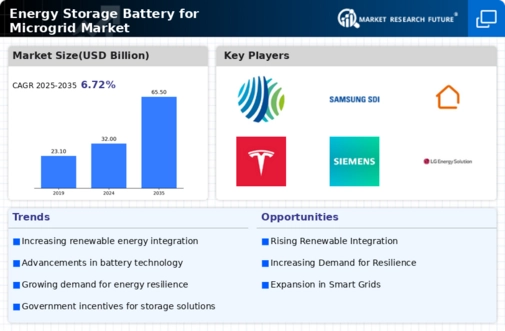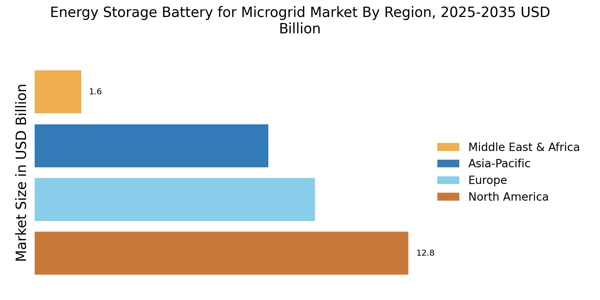Decentralization of Energy Systems
The shift towards decentralized energy systems is reshaping the Energy Storage Battery for Microgrid Market. As consumers increasingly adopt distributed energy resources, such as solar panels and wind turbines, the need for efficient energy storage solutions becomes paramount. Microgrids, which can operate independently or in conjunction with the main grid, are becoming essential for managing localized energy production and consumption. This decentralization trend is supported by advancements in battery technologies, which enhance the efficiency and capacity of energy storage systems. Market data indicates that the demand for decentralized energy solutions is expected to rise, further propelling the growth of energy storage batteries within microgrids.
Rising Demand for Energy Resilience
The increasing frequency of extreme weather events and natural disasters has heightened the need for energy resilience. As communities seek to ensure uninterrupted power supply, the Energy Storage Battery for Microgrid Market is witnessing a surge in demand. This trend is particularly evident in regions prone to outages, where microgrids equipped with energy storage solutions provide a reliable alternative. According to recent data, the market for energy storage systems is projected to grow significantly, driven by the necessity for backup power and enhanced grid stability. The integration of energy storage batteries into microgrids not only supports local energy needs but also contributes to overall grid reliability, making it a critical component in modern energy infrastructure.
Economic Incentives and Financial Viability
Economic incentives play a pivotal role in the expansion of the Energy Storage Battery for Microgrid Market. Governments and regulatory bodies are increasingly offering financial support, such as tax credits and grants, to encourage the adoption of energy storage technologies. These incentives not only lower the initial investment costs but also enhance the financial viability of microgrid projects. As a result, more stakeholders are likely to invest in energy storage solutions, recognizing their potential for long-term savings and operational efficiency. Market analysis suggests that the financial landscape for energy storage is becoming more favorable, which could lead to a substantial increase in the deployment of energy storage batteries in microgrids.
Technological Innovations in Energy Storage
Technological innovations are driving the evolution of the Energy Storage Battery for Microgrid Market. Recent advancements in battery chemistry, such as lithium-ion and solid-state technologies, have significantly improved energy density, lifespan, and safety. These innovations enable microgrids to store larger amounts of energy more efficiently, making them more attractive to consumers and businesses alike. Furthermore, the integration of smart technologies allows for better energy management and optimization within microgrids. As these technologies continue to develop, the market for energy storage batteries is expected to expand, providing enhanced solutions for energy storage in microgrid applications.
Growing Focus on Sustainability and Carbon Reduction
The Energy Storage Battery for Microgrid Industry. As nations commit to reducing greenhouse gas emissions, the transition to cleaner energy sources becomes increasingly critical. Energy storage batteries play a vital role in this transition by enabling the effective use of renewable energy sources, such as solar and wind. By facilitating energy storage during peak production times, these batteries help to balance supply and demand, thereby reducing reliance on fossil fuels. Market trends indicate a growing investment in energy storage solutions as part of broader sustainability initiatives, which is likely to drive the adoption of energy storage batteries in microgrids.


















Leave a Comment